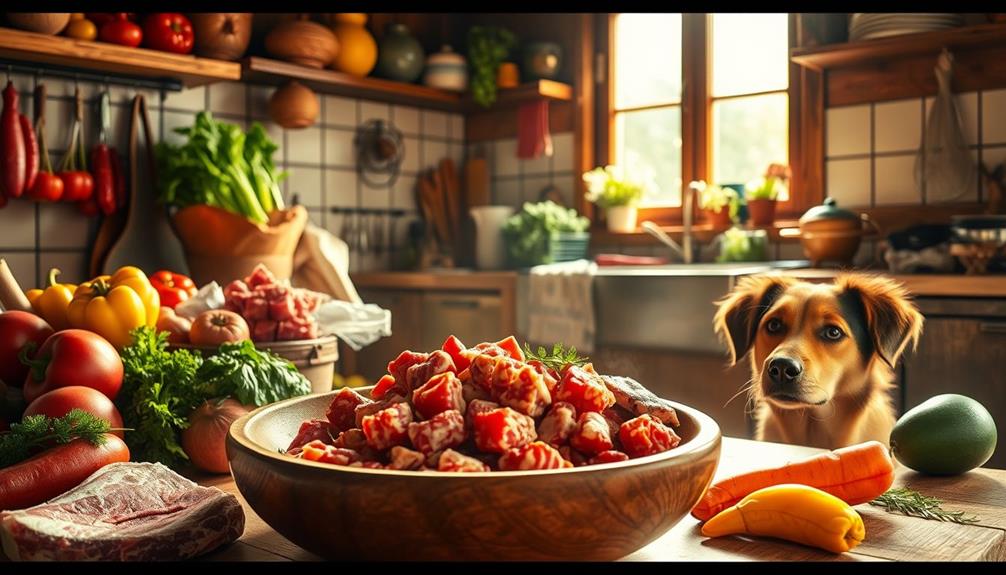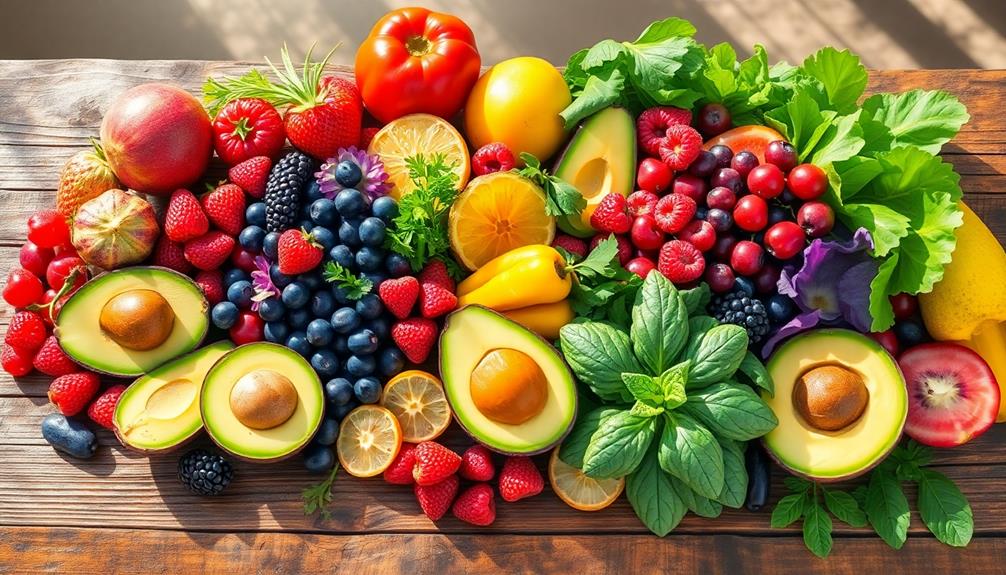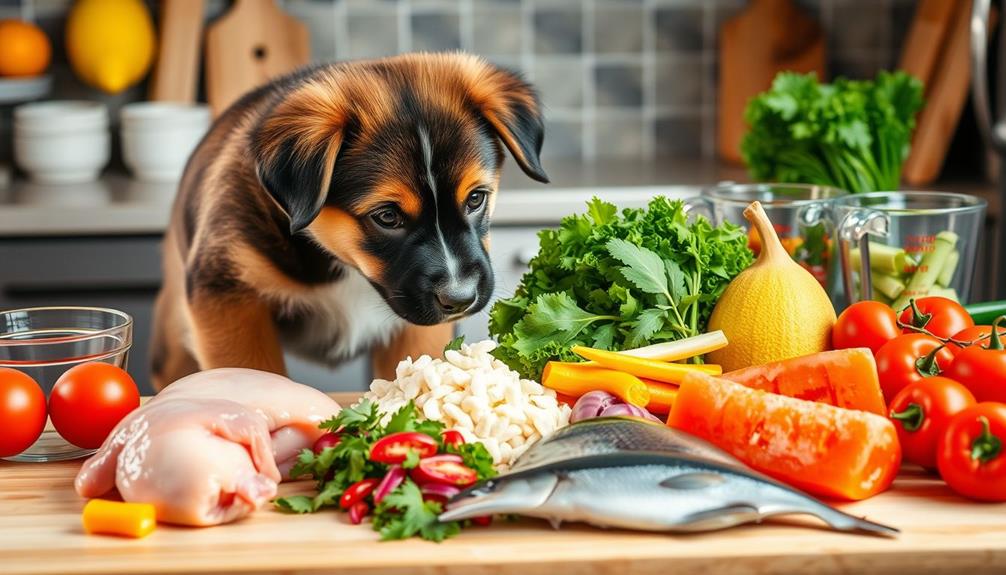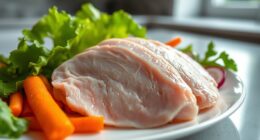To feed your dog raw food daily, aim for about 2-3% of their ideal body weight. Smaller dogs under 5 lbs may need around 5-6%, while puppies start at 5-10% and decrease to about 5% by six months. It's best to divide daily amounts into two meals for better digestion. For example, a 30kg dog requires roughly 600-900g of raw food each day. Monitoring your dog's weight and health is essential for making adjustments. There's a lot more to reflect on regarding shifting to a raw diet and its benefits, so keep exploring to get all the details. If you’re unsure about how much raw food to feed your dog, there are online resources available, such as a raw food calculator for dogs, which can help determine the appropriate portion sizes based on your dog’s weight and activity level. Additionally, consulting with a veterinarian or a canine nutritionist can provide valuable guidance for transitioning to a raw diet and ensuring your dog is receiving the necessary nutrients. By taking these steps and staying attentive to your dog’s well-being, you can provide them with a balanced and nourishing raw food diet.
Key Takeaways
- Adult dogs require 2-3% of their ideal body weight in raw food daily, while smaller dogs may need 5-6%.
- Puppies should receive 5-10% of their body weight in raw food, decreasing to about 5% by six months.
- Use a raw food calculator for tailored feeding guidance based on your dog's weight.
- Transition to a raw diet gradually over 7-10 days to prevent digestive issues.
- Regular health checks and monitoring of your dog's condition are essential for dietary adjustments.
Understanding Raw Food Portions
When it comes to feeding your dog, understanding raw food portions is fundamental for their health and well-being. For an adult dog, you'll typically want to provide about 2% to 3% of their ideal body weight in raw food per day. For instance, if your dog weighs 10kg, that translates to an amount of raw food between 200g to 300g daily. The amount of raw food for dogs can vary based on their activity level, metabolism, and other individual factors. It’s important to monitor your dog’s weight and adjust their raw food portions accordingly to ensure they are maintaining a healthy weight. Additionally, consulting with a veterinarian or a canine nutritionist can provide valuable guidance on determining the ideal amount of raw food for your specific dog.
Smaller dogs, particularly those under 5 lbs, might require a higher percentage, needing about 5-6% of their body weight in food each day. Proper nutrition is essential, as routine health checks for signs of illness or injury can help guarantee your dog's dietary needs are being met.
It's important to assess your dog's activity level when determining the right amount of food. More active dogs may need an increase in their daily intake, while less active ones might require less.
To get the most accurate feeding guidance, consider using a raw food calculator. This tool can help you personalize the amount of raw food based on your dog's weight and dietary needs.
Feeding Guidelines for Adult Dogs
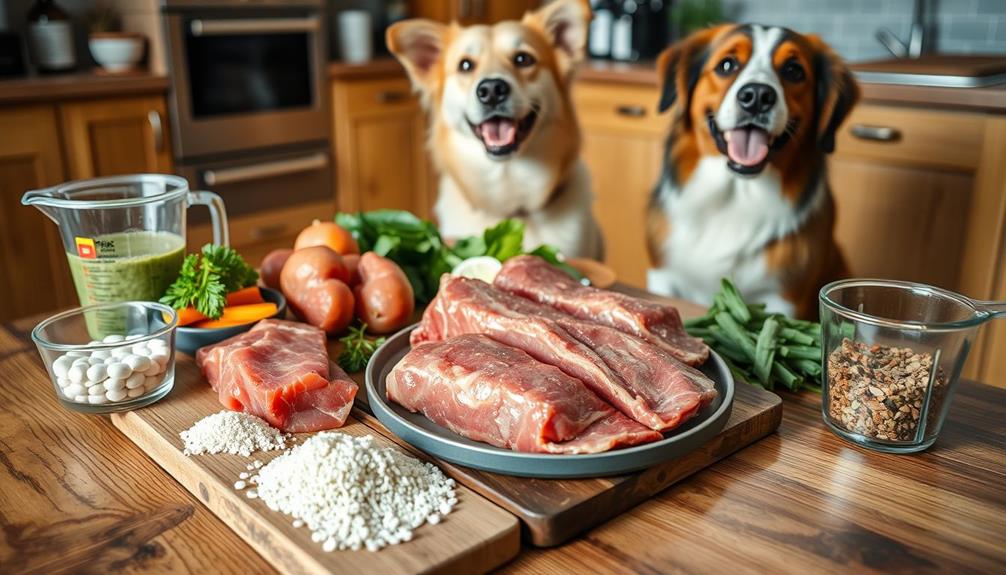
Feeding your adult dog the right amount of raw food is fundamental for their health and well-being. Adult dogs typically require a daily portion of 2-3% of their ideal body weight in raw food. For instance, if your dog weighs 30kg, you should aim for approximately 600-900g of raw food each day.
Start at 2-2.5% of their body weight and adjust based on regular weight monitoring. Providing high-quality protein sources in their raw diet can enhance their energy levels and overall vigor, leading to a happier pet. Additionally, incorporating healthy dog snacks can promote their well-being alongside their raw food diet.
Smaller dogs often need a higher percentage of their body weight compared to larger dogs due to their faster metabolism. To help with digestion and keep their energy levels stable, it's advisable to divide the total amount of food you feed per day into two meals.
Regularly monitoring your dog's weight is essential. If you notice they're gaining or losing weight, adjust their food intake accordingly to guarantee they maintain a proper weight.
This proactive approach to raw feeding will support your adult dog's overall health and help them thrive. Remember, finding the ideal body weight is a continuous process, and staying attentive to their needs will lead to a happier, healthier life for your furry companion.
Puppy Feeding Requirements

As your puppy grows, their nutritional needs differ markedly from those of adult dogs. Puppies generally require a higher amount of food, specifically 5-10% of their body weight in raw food daily.
Understanding costs associated with assisted living can provide insights into the importance of budgeting for your pet's dietary needs. By the time they reach six months of age, this amount typically decreases to about 5%. It's crucial to feed your puppy the right amount to support their development.
You should start introducing raw food for your dog as early as 5-8 weeks, offering three small meals per day. As they grow, gradually reduce the frequency to two meals daily.
The exact amount to feed can be determined using a raw dog food calculator, which takes into account your puppy's age and weight.
Transitioning to Raw Diet
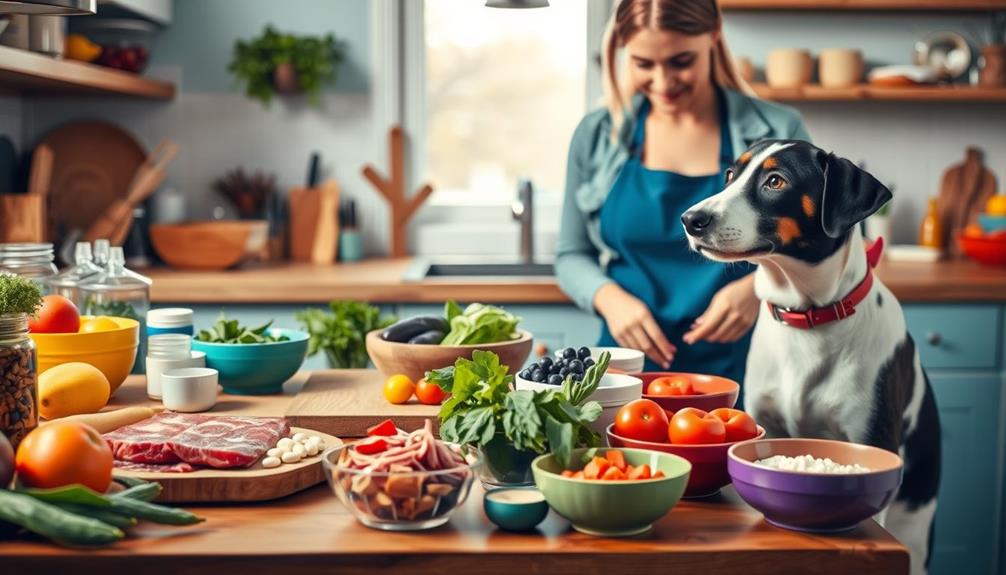
Shifting your dog to a raw diet can be a rewarding journey, but it requires careful planning. Start with a gradual introduction over 7-10 days to minimize digestive issues.
During the initial week of the change, you might notice some weight loss, typically due to water weight, but this should stay within 1-2% of your dog's body weight weekly. It's important to guarantee that your dog is getting all necessary nutrients, similar to how one should consider nutritional needs for cold medications in humans.
It's vital to collaborate with a veterinarian throughout this process. They can help guarantee you're meeting your dog's nutrition needs effectively.
As you begin adapting to a raw diet, choose a couple of raw food recipes to feed your dog and gradually increase the variety as they adapt. This can enhance their diet and keep meals exciting.
As you proceed, monitor the dog's response closely. Pay attention to their digestion and overall well-being, as adjustments may be needed based on how they react to the new food.
With patience and careful observation, you'll find the right balance that works for your furry friend. Remember, this change isn't just about altering what you feed your dog; it's about nurturing their health and happiness!
Benefits of Raw Feeding
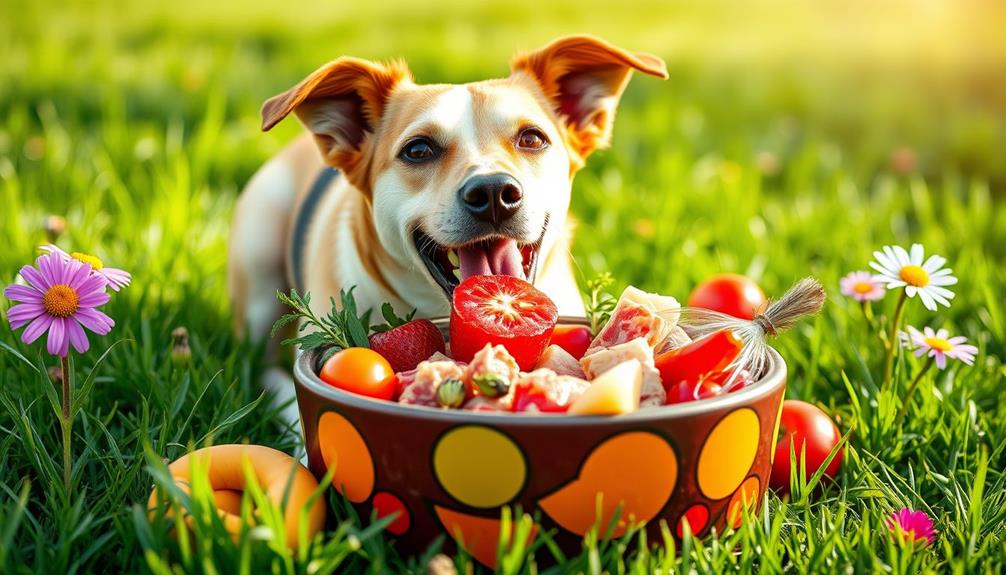
When you switch your dog to a raw food diet, you might notice improved digestion efficiency and a better nutritional balance.
This change can lead to smaller, firmer stools and enhanced absorption of essential nutrients. Additionally, a raw diet may provide your dog with higher levels of vitamins and antioxidants, promoting overall health benefits similar to those observed with Cranberry Juice Consumption.
Plus, the benefits often extend beyond just digestion, positively impacting your dog's overall health.
Improved Digestion Efficiency
Many dog owners notice remarkable improvements in their pets' digestion efficiency after switching to a raw food diet. By feeding your dog nutritious raw food, you're likely to see better nutrient absorption, which means your dog can derive more benefits from the same amount of food.
This approach aligns with the concept of a balanced diet, as it provides essential nutrients that support overall health. Many dogs produce smaller, firmer stools when on a raw diet, indicating that their bodies are effectively utilizing what they eat. As part of lifestyle for longevity, raw feeding can promote better digestion and overall well-being.
When considering how much raw food to feed per day, remember that dogs generally require less overall food compared to kibble for the same nutritional benefit. This reduction in quantity can be particularly beneficial for maintaining your dog's ideal body weight.
Even adding just 25% raw food to your dog's diet can enhance digestion and may help alleviate allergy symptoms. If your dog's adult weight is a concern, focusing on improved digestion efficiency through raw feeding can strengthen their immune system and contribute to overall health.
Enhanced Nutritional Balance
Raw feeding not only improves digestion but also enhances the nutritional balance in your dog's diet. By incorporating raw food, you're ensuring your pup receives essential amino acids, vitamins, and macronutrients that help maintain an ideal body weight and promote a healthier lifestyle.
When feeding your dog a raw diet, you're reducing fillers and artificial additives often found in processed foods, leading to cleaner teeth and healthier skin. Additionally, just as in key domains of development, the right nutrition plays an important role in your dog's growth and overall well-being.
The benefits of raw food extend beyond just physical appearance. Improved nutrient absorption means that your dog can efficiently utilize the nutrients they consume, resulting in stronger immune systems and resilience against illnesses.
Even a 25% addition of raw food can greatly reduce allergy symptoms, leading to enhanced comfort for your furry friend.
As you consider what food should I feed my dog, remember that a balanced raw diet contributes to their overall well-being. With proper nutrition, your dog can enjoy an active lifestyle, full of energy and vitality.
Ultimately, feeding your dog a raw diet not only fosters physical health but also supports their happiness and quality of life.
Using a Raw Food Calculator
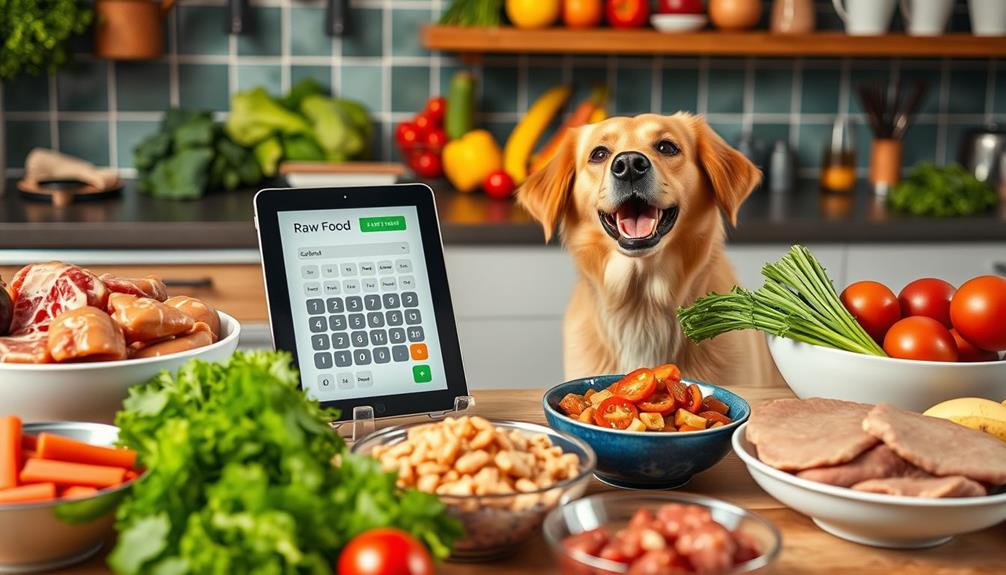
A raw food calculator can be a valuable tool for determining the right amount of raw food for your dog each day. To use it effectively, you'll need to input your dog's weight in pounds, which helps establish baseline feeding recommendations tailored to their needs.
You can also select the percentage of their diet that consists of raw food, typically ranging from 10% to 100%. Understanding your dog's nutritional needs is similar to setting savings goals for your finances, as both require careful planning and monitoring.
This calculator provides guidance on how much raw food to feed, allowing you to determine how much raw food fits your dog's individual requirements. Regular monitoring of your dog's weight and overall condition is vital.
As you observe your dog's health, you may need to make adjustments to feeding based on their ideal weight and response to the diet.
Remember that the raw food calculator serves as a guideline rather than a definitive rule. It's important to pay attention to your dog's overall condition and adjust accordingly to guarantee they thrive.
Frequently Asked Questions
How Much Raw Food to Feed a Dog per Day?
To determine how much raw food to feed your dog daily, consider their ideal body weight, activity level, and health. Generally, aim for 2-3% of their weight, adjusting as needed for peak health.
What Is the 80 10 10 Rule for Raw Dog Food?
Imagine a wild wolf's feast; the 80/10/10 rule mirrors that. You'll give your dog 80% muscle meat, 10% organ meat, and 10% bones, creating a balanced, nutritious diet that supports overall health and vigor.
How Much Does 1 Cup of Raw Dog Food Weigh?
When you measure raw dog food, 1 cup usually weighs between 8 to 10 ounces. It varies based on ingredients, so using a kitchen scale guarantees you're providing the right portion for your pup.
What Are the Proportions for Raw Dog Food?
When considering proportions for raw dog food, you'll want to assess your dog's weight, age, and activity level. Tailor their diet, adjust portions, and guarantee they receive the nutrition they need for peak health.
Conclusion
As you commence on this journey into raw feeding, think of it as planting a garden for your dog's health. Each meal is a seed, nurturing importance and strength. Just like a garden flourishes with care, so will your furry friend thrive on the right portions. Embrace the process, watch them bloom, and enjoy the vibrant bond that grows between you. By choosing raw, you're not just feeding—you're cultivating a life of wellness and joy.

